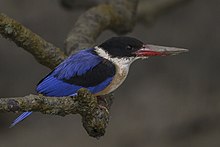H. pileata
| Black-capped kingfisher | |
|---|---|
 |
|
| An adult Black-capped Kingfisher from Sundarban, West Bengal, India. | |
| Scientific classification | |
| Kingdom: | Animalia |
| Phylum: | Chordata |
| Class: | Aves |
| Order: | Coraciiformes |
| Family: | Alcedinidae |
| Subfamily: | Halcyoninae |
| Genus: | Halcyon |
| Species: | H. pileata |
| Binomial name | |
|
Halcyon pileata Boddaert, 1783 |
|
The black-capped kingfisher (Halcyon pileata) is a tree kingfisher which is widely distributed in tropical Asia from India east to China, Korea and Southeast Asia. This most northerly of the Halcyonidae is resident over much of its range, but northern populations are migratory and they wintering south of their range to Sri Lanka, Thailand, Borneo and Java. It is distinctive in having a black cap that contrasts with the whitish throat, purple blue wings and the coral red bill. The species is mainly found in coastal and mangrove habitats but can sometimes be found far inland.
The black-capped kingfisher was given the binomial name Alcedo pileata by the Dutch naturalist Pieter Boddaert in 1783. A description of the kingfisher without a scientific name had been published a few years earlier by the French polymath Georges-Louis Leclerc, Comte de Buffon. The present genus Halcyon was introduced by the English naturalist and artist William John Swainson in 1821.Halcyon is a name for a bird in Greek mythology generally associated with the kingfisher. The specific epithet pileata is from the Latin pileatus meaning "-capped".
This kingfisher is about 28 centimetres (11 in) long. The adult has a purple-blue wings and back, black head and shoulders, white neck collar and throat, and rufous underparts. The large bill and legs are bright red. In flight, large white patches or "mirrors" at the base of the primaries are visible on the blue and black wings. Sexes are similar, but juveniles are a duller version of the adult and show streaks on the throat. The call of this kingfisher is a cackling ki-ki-ki-ki-ki.
Usually seen on coastal waters and especially in mangroves, it is easily disturbed, but perches conspicuously and dives to catch fish but also feeds on large insects. The flight of the black-capped kingfisher is rapid and direct, the short rounded wings whirring.
...
Wikipedia

